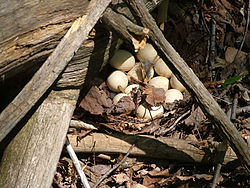Annual report (1903) (14565351888)
Identifier: annualreport101112190newy (find matches)
Title: Annual report
Year: 1902 (1900s)
Authors: New York (State). Forest, Fish and Game Commission
Subjects: Forests and forestry Fisheries Game and game-birds
Publisher: (Albany, N.Y. : The Commission)
Contributing Library: Smithsonian Libraries
Digitizing Sponsor: Biodiversity Heritage Library
View Book Page: Book Viewer
About This Book: Catalog Entry
View All Images: All Images From Book
Click here to view book online to see this illustration in context in a browseable online version of this book.
Text Appearing Before Image:
omelocalities they seem to have been practically exterminated. Various theories have been propounded to account for this scarcity,but these are for the most part merely conjectures. It is unfortunate, thatthe remarkable diminution in numbers had not been noted much earlierin the year and at the time the causes to which the scarcity is due wereat work, for we might then have been able to determine exactly what wasthe trouble. However, enough data have been gathered on which to basean explanation which may be accepted as substantially correct. Before coming to any conclusion, it will be well to take up and discusseach of the several theories proposed, with the facts given to substantiatethem. The following theories have been offered as a possible explanation ofthe grouse scarcity: 1. The deep snow and extreme cold of the latter part of the winterof 1906-7, killing off the old birds by freezing and starvation. 2. The unusual abundance of foxes, goshawks, and other bird andanimal enemies.
Text Appearing After Image:
z zJ (D D J Ju CO D<< z0m LI 0 Q h < Q. LI(/) D 0 0 QLiLL D THE SCARCITY OF RUFFED GROUSE IN I907. 373 3. The unusually cold, wet and late spring of 1907, chilling the eggsand killing such of the young birds as were successfully hatched. 4. The extreme dryness during July and August, 1907, killing prac-tical! v all the voung and many of the old birds through their inability tofind water. 5. An epidemic of disease. (Most of the data given to substantiatethis might apply equally well to the following theory.) 6. An internal parasite. 7. An external parasite ( ticks ). 8. Shooting and snaring by pot-hunters during the closed season. 9. The resumption of an innate migratory instinct causing the birdsto leave the section in which thev had been raised. Discission 1. Many people put the blame on the intense cold and scarcity of foodin the latter part of the winter of 1907, but only tworeports that mightsupport this theory have been seen. In Saratoga county, N. Y., a game protector r
Note About Images
Relevantní obrázky
Relevantní články
Jeřábek kanadskýJeřábek kanadský je středně velký druh tetřeva obývající lesnaté oblasti severu Spojených států amerických a střední a jižní části Kanady. Jedná se o jediného zástupce monotypického rodu Bonasa. Je to pták zavalitého tvaru s malou hlavou, zakulacenými křídly, silnýma nohama a dlouhým ocasem, který má při rozevření vějířovitý tvar. Jeřábci mají nenápadné, hnědě zbarvené opeření s bílým a tmavým kropením, které jim pomáhá dobře splynout s okolím. Opeření sahá až dolů až k zánártí, prsty jsou bez peří. .. pokračovat ve čtení


















